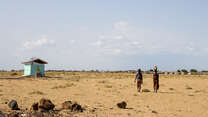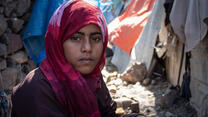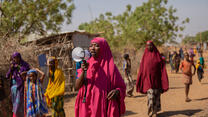SUMMARY
The issue of how the global community can effectively address forced displacement is prominent on the international agenda. Displacement levels are the highest ever recorded with roughly 65 million people forcibly displaced around the world, including over 21 million refugees, three million asylum-seekers and over 40 million internally displaced persons (IDPs).
One in every 122 people in the world is now either a refugee, internally displaced, or seeking asylum. At the same time, displacement patterns are changing. The average length of displacement is between 20 to 30 years and 6 out of 10 refugees are in urban areas, in cities and towns across the globe. At least half of all IDPs are also in urban areas.
A series of meetings and events in 2016 have signalled the priority that governments, financial institutions and aid agencies are giving to the phenomenon – including the World Humanitarian Summit, and two high-level events held in September during the UN General Assembly. Habitat III also presents an opportunity to improve how we manage forced urban displacement in future.
The launch of the Global Alliance for Urban Crises at the World Humanitarian Summit in May 2016 demonstrates a shift in mind-set amongst humanitarian agencies and development actors, who recognise that they are increasingly responding to emergencies – including displacement crises –in urban areas. Members of the Alliance are taking steps to translate policy commitments into changes in the way they operate on the ground.
It is incumbent upon international agencies, member states and other stakeholders to fully recognise that urban displacement is now the norm and to ensure that new funding, policies and operational approaches are appropriately designed and implemented according to where the majority of the forcibly displaced are located. There is a pressing need for international, national and local actors to work together to ensure their towns and cities are able to absorb additional populations in ways that are dignified, foster self-reliance and which address the needs of both displaced populations and the communities that host them. This requires managing protracted and forced displacement as both a humanitarian and development issue, moving from humanitarian responses designed solely to address short-term need to ones that also contribute to longer-term sustainable urban development.
CONTEXT
With current high levels of displacement, there are now 29 million people forcibly displaced people who have sought safety in a town or city. Eighty-six percent of refugees reside in developing, conflict-affected or low income countries that are already struggling to ensure stability and services for their own populations. Such trends generate new challenges and opportunities for humanitarian actors and demonstrate why the international community must recognise the urban characteristics of displacement, and take the necessary steps to ensure appropriate partnerships and approaches that support towns, cities and host communities, and the displaced populations within them.
Urban areas are dynamic, constantly evolving and, in many parts of the world, centres of diversity and multiculturalism, often built on the labour and economic contributions of migrants and other displaced populations. As well as locations of opportunity, towns and cities are also perceived as places of sanctuary for those fleeing violence, conflict and persecution.
Refugees have particular vulnerabilities, given their status, exposure to the traumas of war and flight and the restrictions on their rights – particularly on the right to work, and in some cases also on their freedom of movement. IDPs are also often vulnerable. Residence requirements may prevent them from working legally, and stigma may prevent them from accessing adequate housing. This leads many to seek shelter in informal settlements where lower levels of security of tenure may increase the risk of further displacement. Those who have lost identification papers can struggle to get formal employment, sign a lease, open a bank account or get a mobile phone. Where the right to work is restricted, displaced people are more likely to enter the informal workforce, which can lead to downwards pressure on wages. For all new arrivals in a town or city, vulnerabilities may be exacerbated by language barriers, lack of familiarity with local norms and customs, social isolation and limited awareness of their rights, entitlements or where to seek help. In general, the urban displaced face a range of legal restrictions and suffer from harassment and insecurity.
FORCED DISPLACEMENT AND DEVELOPMENT
The Sustainable Development Goals (SDGs) make specific reference to displaced populations: recognising their contributions to development and growth, and the need for international cooperation to ensure full respect for their human rights. However, IDPs and refugees find themselves the object of stigma, racism and xenophobic violence. Where they are segregated from other urban populations, and without basic rights and entitlements, displaced people may resort to precarious or illegal livelihood options and housing solutions. Unless steps are taken to prepare for and absorb these additional, often deeply vulnerable populations, they risk being left behind. SDG 11 –the goal of inclusive, safe, resilient and sustainable towns and cities must encompass all urban residents, whether legally ‘citizens’ or not.
Greater recognition and understanding of humanitarian and displacement crises are still needed among urban development specialists. Despite the fact that the history and development of urban areas is intimately linked to migration and displacement, and that towns and cities are themselves at risk of crises, the need to plan for and manage displacement in towns and cities is yet to garner adequate recognition amongst institutions and agencies involved in the development of the New Urban Agenda – the outcome document for the third UN Conference on Housing and Sustainable Urban Development (Habitat III) in October 2016. This Agenda does not fully address the needs of displaced populations in urban areas. The call for inclusive models of urbanisation that anticipate and incorporate population movements, promote and protect the rights of the displaced and, while building on their capacity, respond to humanitarian and development concerns in synergy, could have been articulated more strongly.
LIMITATIONS OF CURRENT HUMANITARIAN RESPONSES
Humanitarian agencies developed their tools and approaches responding to refugee crises in rural areas, often along remote borders. In some instances, aid agencies established new settlements or camps almost from scratch, and took on the responsibility to provide for every aspect of refugees’ lives. This way of working does not translate well to an urban environment, where public and private provision of services is often well-established, and there will be a variety of shelter options, diverse livelihood opportunities and functioning markets. In these cases, the most efficient response to the needs of refugees is often to promote their access to existing services and markets, while taking care not to overburden existing urban systems.
This is proving difficult for many humanitarian agencies, who tend to provide assistance based on an assessment of needs of individually registered refugees and their families. To their credit, many agencies are now seeking to limit the extent to which services for refugees are provided through newly established parallel structures. They have recognised that this is not cost-efficient, and does not aid good relationships between host communities and the displaced. The increasing use of cash transfers has done much to promote displaced populations’ access to goods and services available in local markets, although achieving this without distorting prices can be a challenge. Still lacking, however, is adequate appreciation of the massive pressure on the public services that are used and relied upon by both refugees and host communities. Health and education services for displaced populations are a priority for humanitarian actors and donors, but the pressure on municipal or urban services is not routinely addressed during displacement crises. These services include waste collection, transport, street lighting, and maintenance of roads and other public infrastructure, including water and sanitation. These shared public goods are often unfamiliar territory to those traditionally responsible for responding to refugees’ needs, but failure to support urban services can create social tensions. In protracted crises, additional strain on services can lead to systemic collapse, further weakening the resilience of both host and displaced populations.
Tensions can also arise over competition in labour and housing markets, and emergency response is generally not informed by longer-term planning or sustainable development concerns. Local authorities and national governments may treat IDPs and refugees as temporary, transient populations. This attitude can lead to inadequate or inexistent provision of services and support, which undermines the long-term abilities of displaced people to live fulfilled lives. Humanitarian agencies lack the skills to engage with municipal authorities and may not have staff experienced in delivering system-based solutions that are appropriate for local residents as well as displaced people.
The conundrum of where and how to house large influxes of displaced people is of particular concern in urban areas. Using schools or community spaces as temporary shelters causes tension with the host community. Camps provide little dignity and generate protection risks. They can morph in to a long-term problem as they often become permanent, with very poor standards of living, disconnected from vital city systems. The principal alternative for refugees and IDPs who arrive without assets (or once these are depleted) is to move to informal areas of the city where rents are cheapest.
There they are often exposed to natural and other hazards, including violence and environmental contamination. Poor quality shelter can, in particular, exacerbate risks of gender-based violence for women. In general, movement of displaced people to informal settlements contributes to patterns of social and spatial segregation characteristic of many of the world’s towns and cities. Despite beliefs to the contrary, people displaced from rural to urban areas by civil conflict do not necessarily return home once peace is restored.
The Global Alliance for Urban Crises is working to address some of these challenges and gaps. Its Urban Crises Charter calls for the management of urban displacement as a ‘combined human rights, development and humanitarian concern’ and advocates for responses that balance the needs of the displaced with those of the host community. Members of the Alliance are taking steps to translate policy commitments in to changes in the way they operate on the ground, and build the evidence base on appropriate and cost-effective responses. Some of these members are development agencies who recognise the imperative to work with humanitarian colleagues to find the best solutions for urban populations, their local authorities and environments in protracted displacement crises.
WHAT NEEDS TO CHANGE?
NATIONAL LEVEL
Legislation and policies governing responses to refugee and other forced migration movements are often national. But the impacts of this displacement are felt acutely at the local level – overwhelmingly in urban areas. Municipal authorities are not often involved in the formulation or implementation of migration and refugee policies, nor is migration and displacement necessarily taken in to account in the development of national urban policies. However, given that displaced people are predominantly in urban areas, the role of municipal authorities in responses to displacement should be set out in national frameworks. Critically, their contribution must be taken in to account in funding mechanisms, coordination models and provision of holistic, long-term solutions. Internal financial transfers need to be in place so that municipalities can deal with the additional pressure on urban services generated by displacement. They also should be assisted to ensure local development plans meet the needs of all urban residents, including the displaced.
Displaced people often resort to working in the informal sector, if they do not have the right to work legally. Policies that allow refugees and IDPs to work can contribute to economic growth and greater tax revenues for hosting cities and countries.
Legislative and regulatory frameworks should allow for temporary measures when addressing shelter needs in situations of acute displacement, allowing for incremental improvements and greater security of tenure over time.
LOCAL AND MUNICIPAL LEVELS
Towns and cities in regions where flows of refugees and other forcibly displaced people are common need to be prepared to absorb large population movements. This means factoring displacement in to local urban plans, which need to be flexible enough to be adapted to changing situations, so that they can better manage growth.
Where urban areas are at risk of natural disasters, relocation sites should be identified as part of disaster preparedness. These types of contingency and preparedness planning will also require building the capacity of urban authorities and equipping them with the tools to manage displacement well, in both normal times and crises.
Towns and cities have responsibility for everyone living under their jurisdiction, regardless of origin. They can:
- develop policies that help to change perceptions of refugees and IDPs so that they are seen as rights-holders, contributors and partners in the development of towns and cities;
- take early action to resolve any emerging conflicts or tensions.
Cities can also take on responsibility for providing a safe haven to refugees and other vulnerable displaced people. This requires:
- providing assistance to new arrivals, promoting their self-reliance and encouraging incorporation of individuals and families in to the community;
- ensuring access to services and legal support (particularly with regards to tenure and rental agreements); and
- providing information on rights, entitlements and available services in ways that are accessible to people from different backgrounds and who speak different languages.
INTERNATIONAL AGENCIES – HUMANITARIAN AND DEVELOPMENT
Where urban displacement is so large and/or rapid to be considered an ‘emergency’ and has attracted the support and finance of humanitarian agencies, it is critical that development actors - whether local, national or international - are involved at an early stage, to ensure coherence between short-term and longer-term interventions. Given the average length of displacement – estimated at 25 years – there is a clear need for humanitarian and development actors to work together to respond to the challenges of forced migration.
This requires an improved understanding of the city, its economy, services, infrastructure, housing and land markets, alongside an assessment of the specific vulnerabilities and capacities of displaced women and men in urban areas, as compared with host communities. Humanitarian actors can contribute by developing and sharing tools that generate improved understanding of how vulnerability manifests itself in urban settings.
Humanitarian actors should be working to ensure that their interventions strengthen existing urban systems, and are aligned with longer-term urban development goals.
This can include:
- considering the wide range of shelter options already housing people in the city, and supporting authorities and communities to find appropriate housing solutions for the displaced, rather than defaulting to a camp-based solution.
- supporting the creation of livelihood opportunities for displaced populations, ensuring urban areas benefit from the expertise refugees and IDPs bring with them and that those moving from rural areas are able to develop new skills.
Humanitarian agencies should recognise that vulnerability amongst the displaced can be exacerbated by poor relations with host communities. Tensions can be mitigated by:
- delivering assistance through an area-based or settlement approach that considers capacities, vulnerabilities and access to services amongst all residents of a particular location, rather than targeting solely on the basis of status.
- Investing in infrastructure and services, contributing to longer-term sustainable urban growth as well as meeting immediate needs.



